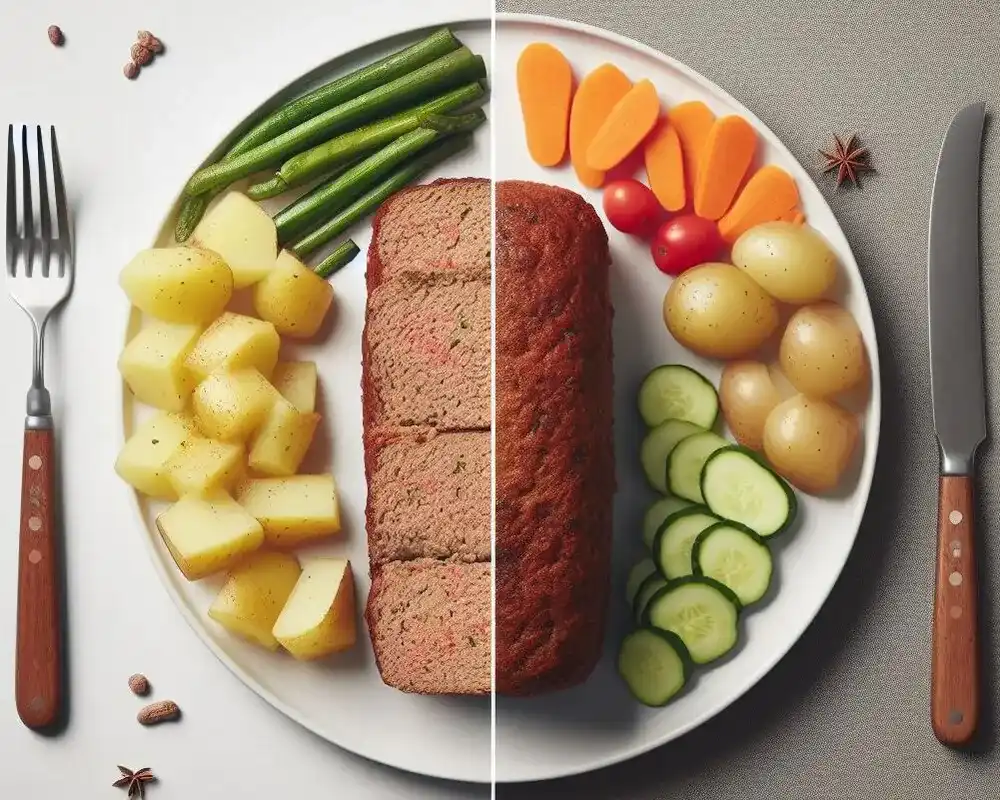Synthetic Meat vs Real Meat – a topic that’s sizzling hot in the culinary world! Did you know that the first lab-grown burger cost a whopping $325,000 in 2013? Now that’s some expensive taste!
But let’s dive into the meat of the matter. Synthetic meat, also known as cultured or lab-grown meat, is a scientific marvel. It’s produced by cultivating animal cells in a lab, eliminating the need for traditional livestock farming. This could be a game-changer in reducing environmental impact and addressing ethical concerns associated with animal farming.
On the other hand, real meat has been a staple in human diets for centuries. It’s a rich source of essential nutrients and has a taste and texture that many find irreplaceable. However, it’s also linked to environmental degradation and ethical issues.
So, the question arises – Synthetic meat vs Real meat – which is the future of our dinner plates? The answer isn’t as straightforward as you might think. It’s a complex issue that intertwines science, ethics, environmental sustainability, and of course, our taste buds.
Stay tuned as we carve into this topic, exploring the pros and cons, the whys and hows, and the deliciously debatable future of meat consumption. Bon appétit!
Table of Contents
The Birth of Synthetic Meat
The concept of synthetic meat, also known as lab-grown or cultured meat, emerged in the early 2000s. This innovative approach to meat production involves cultivating animal cells in a lab, bypassing traditional livestock farming. The birth of synthetic meat marked a significant shift in the way we think about food, intertwining science, ethics, and sustainability in a whole new way.
The First Lab-Grown Burger: A Pricey Affair
Fast forward to 2013, the world witnessed a culinary milestone – the first lab-grown burger. Cooked and tasted at a press conference in London, this burger was not your average patty. It was a product of rigorous scientific research and a hefty price tag of $330,000.
Scientists at Maastricht University in the Netherlands took cells from a cow and turned them into strips of muscle in a lab. These strips were then combined to form a patty, marking a significant step in the journey of synthetic meat from concept to reality.
The taste testers found the texture of the lab-grown burger surprisingly similar to real meat, although they noted it was not as juicy. Despite the absence of natural fats, the burger had an intense flavor. The consensus was that it tasted like meat, not a meat substitute.
This groundbreaking event demonstrated the potential of synthetic meat as a sustainable and ethical alternative to traditional meat. However, it also highlighted the challenges ahead, particularly in terms of cost and scalability.
In the grand scheme of Synthetic Meat vs Real Meat, the birth of the first lab-grown burger was a pivotal moment. It sparked a global conversation about the future of meat and set the stage for further advancements in the field of cellular agriculture.

The Science Behind Synthetic Meat
The science of synthetic meat, or lab-grown meat, is a fascinating blend of biology and technology. It involves cultivating animal cells in a lab, creating a product that’s identical to conventional meat on a cellular level. This scientific breakthrough has the potential to revolutionize the way we produce and consume meat, addressing many of the environmental and ethical issues associated with traditional livestock farming.
Cultivating Cells: The Lab-Grown Process
The process of creating synthetic meat begins with acquiring and banking stem cells from an animal. These cells are then grown in bioreactors, also known as cultivators, at high densities and volumes. It’s similar to what happens inside an animal’s body, where the cells are fed an oxygen-rich cell culture medium made up of basic nutrients such as amino acids, glucose, vitamins, and inorganic salts, and supplemented with growth factors and other proteins.
Changes in the medium composition, often in tandem with cues from a scaffolding structure, trigger immature cells to differentiate into the skeletal muscle, fat, and connective tissues that make up meat. The differentiated cells are then harvested, prepared, and packaged into final products.
This process, which takes between 2-8 weeks depending on the type of meat being cultivated, is a testament to the marvels of modern science. It’s a step towards a future where Synthetic Meat vs Real Meat is not just a debate, but a choice that consumers can make based on their personal preferences and values.
The Environmental Impact of Real Meat
In our environmentally aware society, the ecological consequences of conventional meat production have become a prominent discussion. The conventional raising of livestock plays a substantial role in the release of greenhouse gases, deforestation, and water pollution. This intricate matter intricately connects our dietary decisions with the well-being of our planet.
Livestock Farming: A Major Contributor to Climate Change
Livestock farming plays a significant role in contributing to climate change, accounting for nearly 15% of global greenhouse gas emissions—surpassing the combined emissions from all transportation sources. The process of livestock farming demands substantial water resources and contributes to deforestation and the loss of biodiversity.
The primary culprits behind greenhouse gas emissions in livestock farming are methane and nitrous oxide. Methane, generated during the digestion process in ruminant animals such as cows, sheep, and goats, is 25 times more potent than carbon dioxide. Nitrous oxide, which is nearly 300 times more potent than carbon dioxide, arises from both manure and the use of fertilizers for cultivating feed crops.
The impact of livestock farming on climate change is further intensified by deforestation. Forests serve as crucial carbon sinks, absorbing carbon dioxide from the atmosphere. When these forests are cleared for livestock farming, not only is this essential function compromised, but the stored carbon is also released back into the atmosphere.
In the ongoing discourse between Synthetic Meat and Real Meat, comprehending the environmental repercussions of real meat becomes imperative. This understanding underscores the pressing necessity for adopting sustainable alternatives and practices within our food systems.
Synthetic Meat: A Greener Alternative?
Lab-grown meat, also known as synthetic meat, is frequently presented as a more environmentally friendly option compared to traditional meat. The production process in laboratories has the potential to lessen the environmental impact typically associated with conventional livestock farming. Nevertheless, the ecological implications of synthetic meat are intricate and contingent on multiple factors, such as the energy sources employed during production.
Reducing Carbon Footprint: The Potential of Lab-Grown Meat
Cultivated meat, grown in labs, holds the promise of drastically slashing the carbon emissions associated with meat production. Research conducted by Oxford University and Amsterdam University suggests that this innovative approach could diminish greenhouse gas emissions by a staggering 96% in comparison to traditional animal farming, and potentially use 7% to 45% less energy for the same quantity of meat produced conventionally.
However, the environmental implications of lab-grown meat are complex. The current production techniques, which bear resemblance to those employed in pharmaceutical manufacturing, can be heavy on energy consumption and may lead to increased greenhouse gas emissions. Astonishingly, the global warming potential of lab-produced meat, using these methods, could be four to 25 times higher than that of regular beef.
The industry’s goal is to primarily use food-grade ingredients in the production of lab-grown meat, which could render the process more eco-friendly. In this case, the global warming potential of lab-grown meat could range from being 80% lower to 26% higher than that of traditional beef.
In the ongoing debate of Synthetic Meat vs Real Meat, it’s evident that while lab-grown meat has the potential to be a more sustainable alternative, there are numerous hurdles to surmount. The future of meat consumption may very well hinge on our capacity to innovate and enhance these production techniques.

The Nutritional Showdown: Synthetic Meat vs Real Meat
The nutritional showdown between synthetic meat and real meat is a topic of interest for many. Real meat is a rich source of essential nutrients, but it’s also linked to various health issues. Synthetic meat, on the other hand, is a product of science and technology, and its nutritional profile is still being studied.
Comparing Nutrient Profiles: Can Lab-Grown Meat Compete?
When comparing the nutrient profiles of synthetic meat and real meat, the situation isn’t straightforward. While lab-grown meat seems to have a nutritional profile similar to traditional meat, offering potential identical benefits, the exact composition can vary based on production methods and cell types.
An advantage of lab-grown meat is its potential for engineering a healthier nutrient profile, such as lower saturated fat and higher beneficial nutrients. However, turning this idea into reality is a complex task requiring further research and development.
It’s worth noting that despite lab-grown meat replicating the taste and texture of real meat, it lacks the intricate mix of nutrients found in conventionally farmed meat. This includes essential micronutrients and other health-beneficial bioactive compounds.
In the ongoing debate between Synthetic Meat vs Real Meat, the question of nutritional value plays a crucial role. While lab-grown meat holds promise in competing with real meat nutritionally, a deeper understanding of its nutritional profile and health impacts requires more extensive research.
The Taste Test: Can Synthetic Meat Satisfy Our Palates?
The taste of synthetic meat is a crucial factor in its acceptance. After all, food is not just about nutrition, but also about enjoyment and satisfaction. So, can synthetic meat satisfy our palates? Let’s delve into the flavor factor of lab-grown meat.
The Flavor Factor: Does Lab-Grown Meat Taste Like the Real Deal?
When it comes to the flavor of synthetic meat, the final judgment is still pending. Some taste testers have noted that the texture and consistency of lab-grown meat closely resemble real meat. However, it falls short in terms of flavor and juiciness, primarily because meat comprises not only muscle but also fat.
Interestingly, researchers have successfully produced fat tissue in the lab that mimics the texture and composition of naturally occurring fats from animals. This breakthrough could potentially improve the flavor and texture of lab-grown meat.
In a blind taste test comparing lab-grown and conventional chicken, renowned Israeli gastronome Michal Ansky discovered that the lab-grown chicken tasted like chicken but lacked the savory fat that enhances the flavor of traditional chicken. She observed that both samples were somewhat bland, missing the richness that fat provides to chicken breasts.
In the ongoing debate between Synthetic Meat vs Real Meat, the taste test emerges as a crucial factor. While lab-grown meat shows promise in replicating the taste and texture of real meat, further research is necessary to elevate its flavor and make it as succulent and satisfying as traditional meat.
The Ethical Debate: Animal Welfare and Meat Consumption
The ethical debate surrounding animal welfare and meat consumption is a complex and contentious issue. Traditional meat production often involves practices that raise serious ethical concerns, including inhumane treatment of animals and questionable slaughter practices. This has led to increasing scrutiny of the meat industry and growing interest in alternatives like synthetic meat.
Animal Rights: How Synthetic Meat Could Change the Game
Lab-grown meat, created in laboratories using animal cells, has the potential to revolutionize the landscape of animal rights by eliminating the necessity of raising and slaughtering animals, thereby reducing animal suffering significantly.
However, the ethical dimensions of synthetic meat are not straightforward. While it provides a resolution to the ethical challenges tied to traditional meat production, it also introduces new ethical dilemmas. For instance, is it ethical to utilize animal cells without the explicit consent of the animal? Additionally, concerns about potential health risks and the environmental impact of synthetic meat production come to the forefront.
Furthermore, the acceptance of synthetic meat hinges not only on ethical considerations but also on sensory factors like taste, texture, and cost. If synthetic meat falls short in these aspects compared to real meat, it may not be a practical alternative for the majority.
In the ongoing debate between Synthetic Meat and Real Meat, ethical considerations play a pivotal role. While synthetic meat holds promise in addressing ethical concerns linked to traditional meat, it’s evident that further research and open dialogue are necessary to navigate the intricacies of this complex issue.

The Health Implications of Consuming Real Meat
Consuming real meat has both positive and negative health implications. While meat provides essential nutrients like protein, iron, and B complex vitamins, its consumption has also been linked to several health issues, including heart disease, diabetes, and certain types of cancer.
The Dark Side of Meat: Health Risks and Concerns
Concerns about the negative impact of meat consumption are on the rise. Regularly eating meat has been linked to an elevated risk of serious illnesses such as heart disease, diabetes, and pneumonia. For example, consuming 70g of unprocessed or processed red meat daily can increase the risk of heart disease by 15% and diabetes by 30%.
Additionally, those who consume meat tend to be overweight or obese, further heightening their susceptibility to these diseases. This suggests that the health risks associated with meat consumption are not solely attributed to the meat itself but also to the lifestyle and dietary habits linked to regular meat intake.
In the ongoing debate between Synthetic Meat and Real Meat, these health concerns play a significant role. While synthetic meat holds the potential to offer nutritional benefits similar to real meat without the associated health risks, more research is necessary to validate this claim.
Is Synthetic Meat Safe to Eat?
The safety of synthetic meat is a topic of great interest and debate. The U.S. Food and Drug Administration (FDA) has declared a lab-grown meat product developed by a California start-up to be safe for human consumption. However, as with any new food product, it’s important to consider the potential health implications and risks.
Safety First: The Rigorous Testing of Lab-Grown Meat
The safety of lab-grown meat is maintained through thorough testing and regulatory supervision. Before a lab-grown meat product can be deemed suitable for human consumption, it must undergo extensive safety assessments. These evaluations consider various factors, including the risk of pathogen contamination, the nutritional composition of the meat, and the safety of the production process.
Lab-grown meat is manufactured in a controlled environment, significantly lowering the risk of pathogen contamination compared to traditional meat. A 2018 report published in ScienceDirect by a team of researchers suggests that cell-based meat production could reduce the risk of bacterial contamination, such as E. coli and Salmonella.
However, the health implications of consuming lab-grown meats remain uncertain. Many consumers prefer natural products and are hesitant about foods derived from unconventional sources. Consequently, further research is necessary to fully comprehend the long-term health effects of consuming lab-grown meat.
In the ongoing debate between Synthetic Meat and Real Meat, safety stands as a crucial factor. Despite regulatory authorities declaring lab-grown meat safe for consumption, it’s imperative for consumers to make informed decisions based on the latest research and evidence.
The Cost Factor: Can Synthetic Meat Be Affordable?
The cost of synthetic meat is a significant factor in its potential adoption. While the technology to produce lab-grown meat exists, the high cost of production has been a major barrier to its commercial viability.
From $325,000 to Your Dinner Plate: The Price Drop of Synthetic Meat
The price of synthetic meat has seen a dramatic drop since the first lab-grown burger was created. In 2013, the world’s first lab-grown burger cost a whopping $325,000. However, advances in technology and production methods have significantly reduced the cost.
Today, the price of producing a lab-grown burger patty has dropped to just a little more than $11, or $80 per kilogram of the meat. This drastic reduction in cost is due to improvements in the scale of production and the decreasing cost of materials.
However, despite this progress, lab-grown meat is still more expensive than conventional meat. It’s estimated that it will take at least a couple of decades before lab-grown meat can be produced at a scale and cost that makes it commercially viable.
In the Synthetic Meat vs Real Meat debate, the cost factor is a key consideration. While the price of synthetic meat has been decreasing, it still needs to reach a point where it is affordable for the average consumer.

The Future of Meat: What Does It Hold?
The future of meat is a topic of intense debate and speculation. With the rise of synthetic meat and growing concerns about the environmental, ethical, and health implications of traditional meat production, the landscape of meat consumption is poised for significant change.
The Meat of Tomorrow: Predictions and Possibilities
Predictions regarding the future of meat vary widely, with common themes emerging. One notable trend is the emergence of alternative proteins, such as plant-based and lab-grown meats. These alternatives hold the potential to diminish the environmental impact of meat production, address concerns about animal welfare, and introduce novel culinary experiences.
Nevertheless, the transition to these alternatives presents challenges. Technical obstacles must be overcome to achieve large-scale production of lab-grown meat. Additionally, consumer acceptance plays a crucial role, with some individuals open to trying synthetic meat while others approach the concept with caution.
In the ongoing debate between Synthetic Meat and Real Meat, the future appears to involve a blend of both. As technology progresses and consumer perspectives shift, it is likely that the meat market will become more diverse, offering a range of options to accommodate various tastes and values.
Conclusion
In conclusion, the Synthetic Meat vs Real Meat debate is a complex issue that intertwines science, ethics, environmental sustainability, and our taste buds. Synthetic meat, produced in labs from animal cells, presents a potential game-changer in the realm of animal rights and environmental sustainability. However, it also raises new questions about taste, nutrition, cost, and consumer acceptance.
While synthetic meat has the potential to address many of the environmental and ethical concerns associated with real meat, more research is needed to fully understand its nutritional profile, health impacts, and long-term implications. The future of meat may well depend on our ability to innovate and improve these production methods.
As technology advances and consumer attitudes evolve, we can expect to see a more diverse meat market, with a range of options to suit different tastes and values. The future of meat is likely to involve a mix of both synthetic and real meat. As consumers, it’s important for us to stay informed and make choices that align with our personal values and the health of our planet.
FAQ’s
Is synthetic meat really a healthier option than real meat?
The health implications of synthetic meat are still being studied. While it has the potential to be engineered to have a healthier nutrient profile, more research is needed to fully understand its nutritional profile and health impacts.
Can synthetic meat truly replicate the taste of real meat?
Taste is subjective and varies from person to person. Some taste testers have reported that synthetic meat tastes and feels like real meat, while others have noted differences.
Is synthetic meat production really more environmentally friendly than traditional livestock farming?
While synthetic meat production has the potential to reduce the environmental footprint of meat production, the actual impact depends on various factors, including the energy sources used in production.
Is it ethical to consume synthetic meat?
The ethics of consuming synthetic meat are complex and depend on various factors, including personal beliefs about animal rights and the environment.
Will synthetic meat replace real meat in the future?
It’s hard to say. While synthetic meat has the potential to be a viable alternative to real meat, consumer acceptance, cost, and taste are all significant factors that will influence its adoption.
Is synthetic meat safe to eat?
Synthetic meat is subject to rigorous testing and regulatory oversight to ensure its safety. However, as with any new food product, it’s important to consider the potential health implications and risks.
Can synthetic meat provide the same nutrients as real meat?
The nutritional profile of synthetic meat appears to be similar to that of real meat. However, the exact nutritional composition can vary depending on the production methods and the specific type of cells used.
Does the production of synthetic meat involve any animal suffering?
Synthetic meat is produced by cultivating animal cells in a lab, which eliminates the need for raising and slaughtering animals. However, the initial cell lines are typically sourced from animals.
Is synthetic meat suitable for vegetarians and vegans?
This depends on individual beliefs and reasons for following a vegetarian or vegan diet. Some may accept synthetic meat as it doesn’t involve the slaughter of animals, while others may reject it as it still involves the use of animal cells.
Will synthetic meat be affordable for the average consumer?
While the cost of synthetic meat has been decreasing, it still needs to reach a point where it is affordable for the average consumer. This will depend on advancements in technology and production methods.

